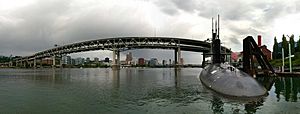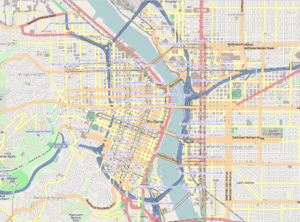USS Blueback (SS-581) facts for kids

USS Blueback (SS-581) in the 1960s
|
|
| History | |
|---|---|
| Namesake | Blueback |
| Awarded | 29 June 1956 |
| Builder | Ingalls Shipbuilding, Pascagoula, Mississippi |
| Laid down | 15 April 1957 |
| Launched | 16 May 1959 |
| Sponsored by | Mrs. Kenmore McManes, wife of Rear Admiral McManes |
| Commissioned | 15 October 1959 |
| Decommissioned | 1 October 1990 |
| Stricken | 30 October 1990 |
| Status | Donated to the Oregon Museum of Science and Industry |
| Badge |  |
| General characteristics | |
| Class and type | Barbel-class diesel-electric submarine |
| Displacement |
|
| Length | 219 ft 6 in (66.90 m) overall |
| Beam | 29 ft (8.8 m) |
| Draft | 25 ft (7.6 m) max |
| Propulsion |
|
| Speed |
|
| Endurance |
|
| Test depth |
|
| Complement | 8 officers, 69 men |
| Armament | 6 × 21 in (533 mm) bow torpedo tubes, 18 torpedoes |
|
USS Blueback
|
|
| Location | Oregon Museum of Science and Industry |
| NRHP reference No. | 08000947 |
| Added to NRHP | 18 September 2008 |
The USS Blueback (SS-581) was a special submarine that served in the United States Navy. It was part of the Barbel-class, known for its advanced design. The Blueback was in service from 1959 to 1990. After its Navy career, it became a museum exhibit at the Oregon Museum of Science and Industry (OMSI). This submarine was the second Navy vessel to carry the name Blueback.
The Blueback was built by Ingalls Shipbuilding in Pascagoula, Mississippi. Its construction started on April 15, 1957. It was launched into the water on May 16, 1959. Mrs. Virginia McManes, wife of Rear Admiral Kenmore M. McManes, was its sponsor. The submarine officially joined the Navy on October 15, 1959, with Lieutenant Commander Robert H. Gautier in charge. It was the very last non-nuclear submarine to join the U.S. Navy. When it was decommissioned, the U.S. Navy became an all-nuclear submarine fleet, except for one research submarine.
Contents
What's in a Name?
The name Blueback has a couple of possible origins. One idea is that it's named after a type of rainbow trout or steelhead trout. This fish lives in deep water in Lake Crescent in Washington. It has a bluish-black back and white underside.
Another idea is that the submarine is named after the sockeye salmon. This type of salmon is very common on the west coast. It is known for its bright blue color and silver sides.
Life as a Submarine
Early Years and Pacific Journeys (1960s)
In January 1960, the Blueback began its first tests in the Gulf of Mexico. After these tests, it sailed to the Pacific Ocean, passing through the Panama Canal in July. Its first home port was Naval Station San Diego. The submarine then went to Keyport, Washington, for torpedo tests.
In 1961, the Blueback trained near San Diego. It then went on its first deployment to the western Pacific. There, it took part in operations and exercises with the U.S. 7th Fleet. The submarine visited Yokosuka, Japan, before returning to San Diego in September. For the next eight months, it participated in more fleet exercises. In July 1962, the Blueback went into the Mare Island Naval Shipyard for its first major repair.
After repairs in 1963, the submarine moved to its new home port, Pearl Harbor, Hawaii. From there, it sailed to Australia for a special event. It visited cities like Brisbane, Melbourne, and Perth. The Blueback then went to the Philippines for more operations. It also visited Naha, Okinawa, and several cities in Japan. It returned to Pearl Harbor in October.
In March 1964, the Blueback was damaged when a crane fell on it while changing its propeller. It needed repairs in a drydock. Later that year, it helped test the SUBROC missile system. The Blueback acted as a target ship during these tests.
In February 1965, the submarine went on another trip to the Far East. It visited Naha, Hong Kong, and Japan. It also supported American operations in Vietnam. The Blueback returned to Pearl Harbor in June. In September, it went to the Puget Sound Naval Shipyard for another major overhaul.
The repairs finished in September 1966. The submarine then tested its sound and weapons systems. It also helped with a research project in Canada. After visiting Vancouver, it returned to Pearl Harbor in November for more training.
In February 1967, the Blueback started another tour in the western Pacific. It spent seven months training and supporting efforts in the Vietnam War. It visited Hong Kong and Japan. The submarine returned to Pearl Harbor in September. In December, it went into the Pearl Harbor Naval Shipyard for minor repairs.
In 1968, the submarine helped train future commanding officers. It also acted as a target for other ships and aircraft to practice ASW (anti-submarine warfare). In July, it began a five-month trip to the Far East. This trip included special operations and time in Yokosuka. The Blueback returned to Pearl Harbor in December.
Journeys in the 1970s
In January 1969, the Blueback went to the Puget Sound Naval Shipyard for another overhaul. After its repairs and sea trials, it returned to Hawaii in December. In April 1970, the submarine began its fifth trip to the western Pacific. It carried out special operations and visited Japan, Hong Kong, and Guam. It also spent time in the Vietnam war zone. The submarine finished this trip in Pearl Harbor in October.
In February 1971, it went into the Pearl Harbor Naval Shipyard for more repairs. In June, it started another Far East assignment. It arrived in Yokosuka, Japan, in July. The submarine then visited Sasebo and Hong Kong. It traveled to the Vietnam war zone to help train destroyer units. After more stops in Japan, it sailed back to Hawaii in November, arriving in December.
The Blueback spent early 1972 on local operations. In March, it began a long overhaul at the Pearl Harbor Naval Shipyard. It finished these repairs in March 1973. The submarine then trained for its next deployment. In August, it sailed to the Orient. There, it worked with American, Korean, and Taiwanese warships. It visited ports in Japan, Korea, Okinawa, Hong Kong, and the Philippines. In January 1974, the Blueback left the Philippines and visited Taiwan. It then headed back to Hawaii.
The submarine arrived in Pearl Harbor in January 1974. For the rest of the year, it took part in many training operations. It helped surface ships and aircraft, practiced firing torpedoes, and trained future commanding officers.
In early 1975, the Blueback continued local operations. In March, it joined "RIMPAC 75," a large exercise with ships from the United States, Canada, Australia, and New Zealand. After this, it had more repairs. In June, it resumed local operations, including torpedo tests. The year ended with the submarine in Pearl Harbor for upkeep.
In January 1976, it held sea trials and weapons exercises. In February, it began another long overhaul at the Pearl Harbor Naval Shipyard. These repairs finished in December. In February 1977, it took part in "RIMPAC 77." After more torpedo trials, the submarine moved to its new home port, San Diego, in April. In June, it sailed to Santa Marta, Colombia, to join Task Force 138 for UNITAS XVIII. During this deployment, the Blueback visited ports in Colombia, Panama, Ecuador, Peru, and Chile. It returned to San Diego in November.
The submarine started 1978 with upkeep. It visited San Francisco in February. From April to May, its battery was replaced. In May, it sailed to Portland, Oregon, for the Rose Festival. It then trained with Canadian forces off Esquimalt, British Columbia. After visiting Seattle, it returned to San Diego.
In September, the Blueback began its eighth trip to the western Pacific. It stopped in Pearl Harbor and then went to Japan. It worked with the South Korean Navy on special warfare and ASW exercises. In November, it participated in ASW exercises with the Taiwanese Navy. It also took part in a 7th Fleet exercise. The submarine visited Hong Kong and then ended the year in the Philippines for upkeep.
In January 1979, the Blueback provided target services for ships training in ASW. It also worked with Army Special Forces troops. In March, the submarine returned to San Diego. After more local operations and a tender availability, it sailed north in August. It visited Astoria, Oregon, and Seattle. In September, it practiced minelaying. In October, the submarine entered drydock for repairs. It began sea trials in November and then provided ASW services.
Final Years (1980s)
The Blueback spent the first few months of 1980 preparing for an overseas trip. It left San Diego in April and arrived in Okinawa in May. The submarine then took part in ASW exercises in the Philippine Sea. It had upkeep in Yokosuka and then began special operations. In June, it participated in joint exercises with South Korean forces. After visiting Japan, it sailed to the Philippines. There, it took part in an ASW exercise in the South China Sea.
In July, the Blueback went to Korea for more exercises with the South Korean Navy. In August, it visited Japan and the Philippines. It conducted special warfare operations and then visited San Fernando. It also took part in ASW operations with ships of the Royal Navy. After a final stop in the Philippines, the submarine began its journey back to San Diego in September. It arrived in San Diego in October and then continued with training and upkeep for the rest of the year.
Becoming a Museum

The Blueback was officially taken out of service on October 1, 1990. It was stored in the Pacific Reserve Fleet in Bremerton, Washington. On October 30, 1990, its name was removed from the Navy's list of active ships. With the Blueback leaving service, the U.S. Navy no longer had any diesel-electric warships. Only the research submarine USS Dolphin (AGSS-555) remained as a diesel submarine in the fleet for a while longer.

In February 1994, the Oregon Museum of Science and Industry (OMSI) brought the Blueback to Portland, Oregon. Today, it is an interactive part of the museum and a memorial. Its large propeller was removed and placed outside the museum as a National Submarine Memorial. OMSI offers guided tours of the submarine every day. It also has longer, more detailed tours twice a month. The vessel was added to the National Register of Historic Places in September 2008.
The submarine's radio room has been restored by the USS Blueback Radio Club. It has both old military radios and modern amateur radio equipment. These use the submarine's original antennas. The submarine's radio call sign is now W7SUB.
Awards and Recognition
 Vietnam Service Medal with two campaign stars for its service during the Vietnam War.
Vietnam Service Medal with two campaign stars for its service during the Vietnam War.
See also
- USS Albacore (AGSS-569) – another important research submarine that helped design the Barbel-class.



